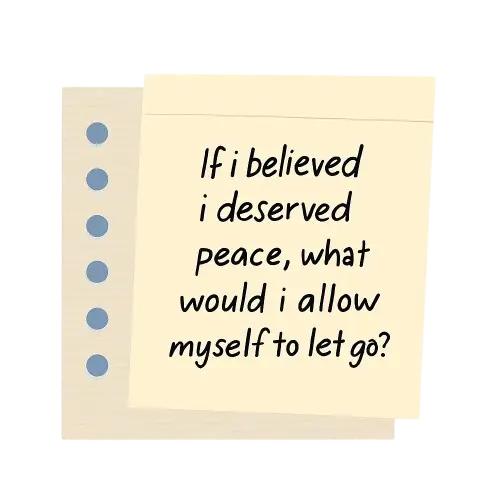Why Can’t I Stop Thinking About What Happened? Understanding the Trauma Loop & How to Break Free
“It’s 2AM, and the memory won’t stop playing. You’re not alone in this.”
It doesn’t matter how long ago it happened. Your body tenses. Your chest tightens. Your thoughts spiral.
You whisper to yourself, “Why can’t I just move on?”
If this sounds familiar, you may be stuck in what mental health professionals call a trauma loop, and knowing what that is may be the first step toward peace.

What Is the Trauma Loop?
A trauma loop is when your brain keeps replaying a painful experience because it hasn’t yet made sense of it; it’s trying to protect you by warning you, over and over.
When you experience something painful or terrifying, your brain kicks into survival mode. It stores the memory not as a normal story with a beginning, middle, and end but as a threat that never fully shuts off.
Instead of processing the experience and filing it away, your brain keeps it close. It’s trying to protect you. It thinks, “If I keep reminding you, maybe we can avoid it next time.”
But instead of helping, it traps you, replaying the same emotional footage with no resolution.
Why Do My Trauma Memories Feel So “Stuck,” Like It Just Happened?
Trauma memories are stored differently from regular memories.
Here’s why:
-
The amygdala, your brain’s fear center, goes into overdrive during trauma.

-
The hippocampus, responsible for placing memories in time and space, goes offline.
-
Your body remembers, even if you try to forget.
That’s why you might:
-
Feel like it just happened, even if it was years ago.
-
Smell something and suddenly feel sick, scared, or numb.
-
Have vivid dreams or flashbacks that come out of nowhere.
These experiences are known as intrusions or intrusive symptoms. It’s common to find that thoughts about the incident pop into your mind without warning, even when you’re not actively thinking about it. You might relive moments in your head or get caught off guard by sudden, vivid memories. Nightmares are another way this shows up, waking up drenched in sweat, or hearing from someone that you were tossing and turning all night, can be signs your mind is still working through what happened.
All of this is your brain’s way of trying to make sense of the trauma, even when you wish it would just let you move on.
What’s the Difference Between Intrusive Memories, Flashbacks, and Nightmares?
Let’s get clear on what’s happening in your brain, because the words can sound technical, but these experiences are very real.
- Intrusive memories are unwanted thoughts or images of the event that pop up without warning, almost like mental “pop-up ads” you never asked for. You could be folding laundry or sitting at work, and suddenly there’s the memory, vivid and unsettling, barging into your mind.
- Nightmares are your brain’s nighttime reruns of the trauma. You might wake up sweating, heart pounding, or feeling like you never really rested at all. These dreams can be literal replays or twisted, symbolic versions of the event.
- Flashbacks are different still. This isn’t just remembering; it’s reliving. In a flashback, it can feel as if you’ve time-traveled right back into the worst moment, as if it’s unfolding around you all over again. Unlike intrusive thoughts, flashbacks can disconnect you from the present, even if just for a few moments.
Everyone’s experience is a little different. Some people only experience one of these, while others might cycle through all three. The main thing to know: none of this means you’re “broken.” It simply means your brain is working overtime to keep you safe.
This isn’t weakness. It’s neurobiology.
Why Doesn’t Trying to Push the Trauma Away Actually Work?
When tough memories or intrusive thoughts show up, it’s natural to want to shove them aside or distract yourself. Who wouldn’t want a break from feeling lousy? But here’s the catch: when you constantly try to bury those thoughts, your brain doesn’t get a chance to actually process or organize what happened. The unresolved memories get “stuck” instead of fading into the background like most experiences eventually do.
So, despite your best efforts, those thoughts often come back, sometimes stronger, and at the most inconvenient moments. It’s not because you’re failing or not trying hard enough. It’s because the brain needs to work through trauma, not just outlast it.
When Do Intrusive Thoughts and Nightmares Mean I Might Have Unresolved Trauma or PTSD?
So, when do those intrusive memories or flashbacks cross the line from “just part of healing” to “something more serious”? If they stick around for weeks, months, or sometimes years and start interfering with your daily life, that’s a big red flag.
Here’s what to watch for:
- Intrusive thoughts or nightmares that don’t fade with time
- Feeling constantly on edge, jumpy, or easily startled
- Avoiding reminders of what happened, even things you used to enjoy
- Persistent feelings of numbness, guilt, or detachment
When several of these symptoms cluster together and don’t let up, it may point to unresolved trauma or post-traumatic stress disorder (PTSD). This isn’t about failing to “move on”, it’s your nervous system’s way of ringing the alarm bells that it still needs support.
What Is Trauma-Focused CBT, and How Can It Help Me Break the Trauma Loop?
So, what actually helps when trauma memories just won’t leave you alone? The approach with the strongest track record is Trauma-Focused Cognitive Behavioral Therapy (TF-CBT).
Think of TF-CBT as giving your brain the map and tools it needs to file away those overwhelming memories:
- You revisit what happened, but this time, it’s with guidance and support, never alone.
- The process helps your brain realize the past is in the past, not something still happening to you.
- Over time (and yes, sometimes you’ll go over the same bits more than once), the memories lose their power to hijack your day.
This isn’t about erasing what happened. It’s about finally being able to remember without reliving. TF-CBT isn’t just a hopeful suggestion, there’s solid research showing it works. If trauma feels like it’s taken control of your thoughts, this is the gold standard for getting that control back.
What Are the Most Common Ways People Cope With Trauma, and Why Can They Backfire?
When intrusive thoughts and feelings hit, it’s natural to want to make them disappear. Most people try things like:
- Pushing the memories away—white-knuckling through by refusing to think about it.
- Distracting themselves with work, Netflix, TikTok scrolling, or even Marie Kondo-ing the entire closet at 2 a.m.
- Throwing their energy into exercise, food, or anything else that quiets the mind.
At first, these tactics can offer a bit of relief. But here’s the catch: when we constantly avoid these distressing memories and feelings, our brain doesn’t get the chance to process or make sense of what happened. Instead of fading, the thoughts and flashbacks have a way of circling back, often popping up when we least expect it.
In short, avoidance feels like a shield, but it can actually keep us stuck on repeat.
You’re Not Crazy, You’re Wired for Survival
Your brain is doing its best with the tools it has.
How Can Trauma-Informed Therapy Help Me Break the Trauma Loop?
Trauma-informed therapy gives you a space to:
-
Understand what’s happening inside you
-
Reprocess the painful memory safely
-
Calm the nervous system
-
Learn how to feel safe again, not just think you should
You don’t have to relive everything to heal. Techniques like:
-
EMDR (Eye Movement Desensitization and Reprocessing)
-
Somatic therapy (working with the body’s memory)
-
CBT (changing unhelpful thought loops)
…are all designed to help your brain learn: the danger is over; you survived.
Trauma-focused CBT, in particular, has some of the strongest evidence for reducing intrusive thoughts. In this approach, you move through your memories in a systematic and safe way, often revisiting them in detail, sometimes repeatedly. Over time, those traumatic thoughts begin to lose their grip, shifting from feeling like a current threat to simply being part of your past. This helps your mind file away the memory where it belongs: as something that happened, not something that’s still happening.
How Do I Know If I’m Caught in a Trauma Loop?
Do any of these sound familiar?
-
You replay the same memory frequently, even if you don’t want to
-
You avoid certain places, people, or sounds
-
You have emotional outbursts that feel bigger than the moment
-
You feel numb, spaced out, or disconnected
-
You’re constantly scanning for danger, even in safe spaces
-
You feel exhausted, but your mind never slows down

What If I’m Not Ready to Talk About What Happened Yet?
You don’t have to talk about everything right away. In fact, trauma counseling often begins with:
-
Grounding exercises
-
Sleep and body regulation
-
Safety-building conversations
-
Letting you set the pace
At WPA Counseling, we meet you where you are. We understand that showing up at all is already an act of bravery.
What Can I Do Right Now When I Feel Stuck in a Trauma Loop?
If you feel stuck in a trauma loop, try this:
🧘 Grounding Technique:
-
Name 5 things you can see
-
4 things you can touch
-
3 things you can hear
-
2 things you can smell
-
1 thing you can taste
This helps bring your nervous system back to the present moment, a small but powerful shift.
What If I Don’t Want to Do This Alone Anymore, How Do I Reach Out for Help?
You might be reading this at a time when no one knows how much you’re hurting. You may feel like you’re “too functional” to ask for help or too far gone to be helped.
But you’re not. You are right where healing begins with awareness.
If this post resonates with you, it might be time to talk to someone who understands trauma and how it shows up quietly in strong people.








